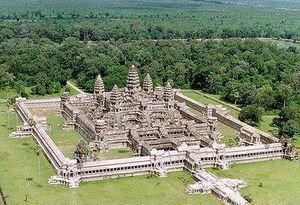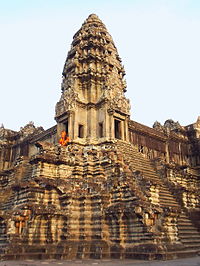Varchas
"The Mirrored City, where Light was always the Law..."[1]
"They worship the sun in Varchas, and have banished darkness from the city."[2]
Varchas, also called the Mirrored City, is a sprawling city of light and mirrors located near the coast of the Elder Continent.
The City of Light
"The walled city of Varchas is a tangle of green vines and luminescent fungal flowers slow-blooming around mouldering stone. A quincunx of carved stepped-towers rise over the walls and pour burning white light into the bleak sky."[3]
"Our ways are not yours, Taamas. Remember that, and walk in the light of Mihir."[4]
Varchas is a beacon that burns brighter than any lighthouse, and it stands stark against the forested darkness of the Elder Continent. Every centimeter of the walled city is lit by some form of light, whether from a lamp, a mirror, or a strange luminescent fungal growth.[3][5] To enter Varchas, one must step into the city's burning gaze and pass through the Mirrored Gate, with permission from the gatekeeper of course.[3]
The citizens of the city worship a deity based on the Sun known as Mihir, and those who leave the light of Mihir in any way are only known as Taamas.[6] Those called Taamas include any and all visitors from the rest of the Neath, and unfortunately they may face discrimination from the city's populace.[7] Zailors don't like this place, and they share horror stories about Varchas that are almost always without bearing.[3]
The Towers and Mirrors
"Your eyes are blinded by the brilliance of the light; the verdant-rot smell is even thicker. The heat of so much flame and reflected light presses oppressively against your skin. Your head pounds."[5]
"Cunningly arranged mirrors catch every droplet of light and diffuse it till each cobblestone and rampart of the city is drenched and blazing and utterly without shadow."[5]
Varchas is primarily lit by its Five Towers. Each Tower houses a powerful light source made of glowing fungi,[8] and atop each Tower lies an enormous, multi-faceted Principle Mirror. These Principle Mirrors are carefully angled and positioned using spring coiled mechanisms to ensure no stone in the city is touched by darkness.[9][5] Other light-sources include the lamps and candle-holders that line every wall, as well as glowing, moss-like fungi.[5]
Four of the Principle Mirrors atop the Towers in Varchas correspond to a cardinal direction: Western, Eastern, Southern, and Northern.[10] The fifth Tower, the Temple Tower, lies at the center of Varchas, where it presides over the most consecrated region of the city. Uniquely, this Tower is the only one of its kind that does not have any mirrors around or within itself, only bright, shining lights.[11]
Each Tower in Varchas also houses a large bell.[12] When all five bells have tolled, the Principle Mirrors are adjusted, the burning lights are dimmed into a softer yellow, and the evenings in Varchas begin.[13]
Professions
""I'm too important to play guide to you, Taamas," she tells you before you even open your mouth. "I'm the Keeper of the Western Principal Mirror," she points up at the enormous multi-faced mirrors set atop each of the city's five Towers."[14]

The Fire-Keepers of Varchas are responsible for maintaining the five Principle Mirrors, as well as adjusting their spring mechanisms.[14][9] Their ranks are drawn from the upper echelons of Varchas,[15] and they are considered extremely important to the city's function, even being part of Varchas' ruling councils.[14][16] In the evenings, they are also responsible for dimming the lights of Varchas into a soft yellow glow using powders.[13]
Lamp-Lighters are responsible for maintaining the lamps and candles that line the walls of the city.[9] They also light the way forward when large groups of citizens leave the city, ensuring that no one in the procession falls to the shadows.[17]
Fungus-Carters, Fungus-Collectors, and Fungus-Harvesters are responsible for harvesting and transporting the various fungi that bloom throughout the city.[18] They are exposed to a disproportionate amount of fungi due to their jobs, and some suffer from a disease called Lung-Bloom, which starts as a severe cough,[18] but over time victims may find fungi growing from their hands, feet, chest, or even eyes and other orifices. Sadly, this disease has no known cure, and only worsens in the heat and light. Victims of Lung-Bloom are also considered to be contagious, and as such are treated in a specialized ward in the Charitable Hospital.[19]
The Guards of Varchas are responsible for maintaining order in the city and monitoring outsiders. Interior Guards wear white cloaks, embroidered with the sun-symbol of Mihir and jeweled with carnelians,[20] and they convene, hold training duels, and receive petitions from the citizenry in the modest but important Guard House.[21][22] Guards in Varchas fight with a light-footed style, and use twin-bladed scimitars as weapons,[21] and they embark on trade missions and hunting expeditions regularly.[23] The Guard is also tasked with ejecting any outsider that overstays their welcome of a single day in Varchas.[24]
Guards who act as gatekeepers for the Mirrored City wear blue cloaks,[25] and are known for their bravery in the face of the Neath's darkness. One wrong step into the shadows, and they too could be declared Taamas.[26] These Guards use ledgers and ring bells to record and declare visitors,[4] and often only accept a few visitors per day.[27]
Mihir and Taamas

|
Beyond this point lie spoilers for Fallen London, Sunless Sea, Sunless Skies, or Mask of the Rose. This may include midgame or minor Fate-locked content. Proceed with caution. You can find out more about our spoiler policy here. |
""In Varchas the sun still shines!" calls the Sun-Priest, in the way of an invocation. The assembled temple-goers raise their voices in well-worn reply, "In Varchas the sun still shines!""[28]
"We must always walk in Mihir's light so we burn our lamps night and day to banish darkness from the Mirrored City. If we let darkness corrupt us we would not be Varchaasi any longer, but Taamas. Like you."[29]

Varchas as a whole is dedicated to the worship of Mihir, a powerful deity based on the Sun. Mihir, through its light, is said to be the watcher of Varchas, and anyone who is born under his gaze is considered a true citizen of the Mirrored City: Varchaasi. Those from the rest of the Neath are pariahs in Varchas, as they left the light of Mihir and are considered to have fallen from his grace forever. It is for this reason that every centimeter of Varchas must remain lit, as citizens who leave the light of Mihir for any reason are no longer considered Varchaasi; they lose their name forever and are from then on only called Taamas.[29] Along with this rule, those who walk in the light of Mihir must practice strict vegetarianism and never kill or maim.[30]
The Temple of Mihir is located within the Temple Tower, serving as the heart of Varchas' Sacred District, located at the city's center. Unlike the other four Towers, the Temple Tower has no mirrors, and is lit only by direct, unreflected lamp-light.[31] The Temple is presided over by the Sun-Priests, the most important of whom are called Sun-Seers.[32] These individuals host sermons and gatherings for devotees and manage the Shrine of Mihir, a stone likeness of the god that is given offerings of flowers and glowing moss regularly.[30]

The ruler of Varchas is the Agnihotri, who rules Varchas with his council of Sun-Seers and Fire-Keepers and presides over the rituals of the Temple.[33] Every few seasons or so the Agnihotri and a large procession of citizens depart from Varchas as part of a pilgrimage to Amaradri, the Mountain of Light.[34] During this time, merchants and other citizens frantically petition the Guard House for a spot on the expedition, perhaps they do it out of religious fervor, or they simply seek trade opportunities.[35] To safely depart the Mirrored City, the Agnihotri and his companions use a massive, strange machine to deposit flammable fungus on the path forward, lighting their way into the shaded darkness of the Elder Continent.[36]
The Song of Mihir is sung in the courtyards with accompaniment provided by string instrumentalists and drummers, as well as prisms that split the white light of the Mirrored City into different colors to match each note.[37] Interestingly, the Varchaasi have two categories of recorded texts: heard texts, which are said to come from the words spoken by Mihir himself, and remembered texts, which are considered second-hand knowledge in comparison. The validity of remembered texts is still a hotly debated issue.[38]
The Story of Varchas
"Mihir looked away away from us, and Varchas fell. Now we light our city like a beacon, so Mihir may find us once more."[28]

The bas-reliefs of the Temple of Mihir detail the tragic tale of Varchas, so that future generations may learn of it. However, the exact veracity of the tale is currently unknown.
It begins with a five-towered city, prosperous and peaceful, languishing under a loving Sun: Mihir. Then, they say, Mihir blinked, and the city crumbled into ruin, falling into the Neath. Now, they say, Mihir roams the Neath looking for his city, while Varchas is irrevocably changed. Ultimately, the priests and priestesses of Mihir hope that the massive amount of light that they produce will help Mihir find them again, in one way or another.[39][28]
Dreams of Smoke

|
Beyond this point lie major spoilers for Fallen London, Sunless Sea, Sunless Skies, or Mask of the Rose. This may include endgame or major Fate-locked spoilers. Proceed at your own risk. You can find out more about our spoiler policy here. |
"Don't touch the mirrors. Don't even look into the mirrors. And try very hard not to dream."[40]
"The Mirror-Mad are worse than Taamas. They no longer serve Mihir but...other powers. Those that speak in dreams and visions."[41]

The Varchaasi are well aware of the powers behind the mirrors, who seek to influence and manipulate the city's citizens for their own mysterious goals. As such, it is advised that one tries not to dream, touch the mirrors,[40] or tell fictional or exaggerated stories.[42] Those who sleep unprotected may experience dreams of smoke, silvered vapors, and one's body warping and twisting as their skin sloughs away...[43]
The Sun-Seers peddle bloodied, viric snakeskin charms and scraps of paper inscribed with secrets that are meant to be hung on any nearby mirrors before sleeping.[44][45] These Mirror-Charms suppress dangerous dreams, but the secrets inscribed on the papers mysteriously fade away after usage.[46]
The Mirror-Mad are those who, upon hearing the whispers from behind the mirrors, ended up whispering back, and are thus subservient to the powers that lurk in the realm of dreams and visions. These poor souls are locked away from mirrors in the Charitable Hospital, and are given food and water to survive, as well as unreflected light, despite the costs.[47]
The Neathers
"Darkness-touched troublemakers! So far all they do is talk and smoke water-pipe and grumble, but I fear that they have strayed from the light of Mihir. Still, my superiors think that they are harmless."[48]
"You are lucky, to be free to wander the Neath at your will. One day, perhaps we Varchaasi will also do the same."[49]

Not all are satisfied with the status quo at Varchas, however. Some individuals, led by the Jewel-Turbaned Youth, have grown resentful of the oppressive rule of the Sun-Priests and the Agnihotri.[50] They especially detest the restrictions on dreaming and storytelling, and they seek ways to gain as much exposure to the outside world as possible through stories, perhaps fabricated ones.[51] However, they are current very inactive as revolutionaries, and are thus considered harmless...[48]
That is, until they gained the push they needed to mobilize into action. Calling themselves the Neathers, these rebels seek to overthrow the government of Varchas as soon as they get the opportunity, allowing them to celebrate their newfound freedom to think and roam the shadows freely.[52] But their motives may go beyond simple political upheaval; many of them have fallen thrall to none other than the Fingerkings,[53] and they show their allegiance with the strange mirror-shards they wear around their necks.[54][52] Their main objective is to snuff out every candle and shatter every mirror in Varchas, potentially allowing the Fingerkings to rule over what remains...[55][56]
Origins and Real-World Parallels

The culture of Varchas has many references to Hindu mythology and culture. Its name, "Varchas", is a variation of "varcas", meaning brilliance of the Sun or fire in Sanskrit, "Mihir" is a variation of "mihira", meaning Sun, and "Taamas" is a variation of "tamas", referring to the darkness of the Sun or Moon during eclipses. "Agnihotri" could be a variation of "agnihotrin", referring to the one responsible for maintaining sacrificial fires, and "Amaradri" could be a reference to "amara", meaning immortal or undying.[57]

Varchas as a whole strongly resembles Angkor Wat, the ancient temple city in modern-day Cambodia, which was known for its magnificent bas-reliefs and had four enormous corner towers and a larger central tower as well. Likewise, Varchas is known for its Five Towers, and note the design of Varchas' towers compared to the images of Angkor Wat in this section; the towers of Varchas strongly resemble Khmer architecture, an architectural style very common in Cambodia around the 8th-15th centuries.[58] The central tower of Angkor Wat also symbolizes Mount Meru, which is said to be the axis on which the Sun and the rest of the Solar System rotate on in Hindu cosmology.[59][60]
While Angkor Wat itself was originally dedicated to Lord Vishnu, it was converted into a Buddhist temple in the 12th century. Perhaps this real-life event inspired the supposed downfall of Varchas.[60]
References
- ↑ Port description, Sunless Sea
- ↑ Varchas: The Mirrored City, Sunless Sea
- ↑ 3.0 3.1 3.2 3.3 The Burning White Light of Varchas, Sunless Sea
- ↑ 4.0 4.1 Tell the Guard you wish to enter, Sunless Sea
- ↑ 5.0 5.1 5.2 5.3 5.4 Inside the City-Walls, Sunless Sea
- ↑ Your name is not Taamas, Sunless Sea
- ↑ The Courtyard (Failure), Sunless Sea
- ↑ The Fallen City of Varchas, Sunless Sea
- ↑ 9.0 9.1 9.2 The Centre of Varchas, Sunless Sea
- ↑ Join the Neather Revolution, Sunless Sea
- ↑ The Temple of Mihir, Sunless Sea
- ↑ Varchas: The Knells of the Towers, Sunless Sea
- ↑ 13.0 13.1 Evening in Varchas, Sunless Sea
- ↑ 14.0 14.1 14.2 The Fire-Keeper, Sunless Sea
- ↑ Hear out the Neathers, Sunless Sea
- ↑ The Agnihotri, Sunless Sea
- ↑ "Wish us luck, Taamas!", Sunless Sea
- ↑ 18.0 18.1 The Fungus-Carter, Sunless Sea
- ↑ The Fungal Infections Ward, Sunless Sea
- ↑ Cite error: Invalid
<ref>tag; no text was provided for refs namedwhite cloaked - ↑ 21.0 21.1 Train with the guards, Sunless Sea
- ↑ Cite error: Invalid
<ref>tag; no text was provided for refs namedguard house - ↑ The Open Ward, Sunless Sea
- ↑ Dawn in Varchas, Sunless Sea
- ↑ Ask the Guard a few questions, Sunless Sea
- ↑ Cite error: Invalid
<ref>tag; no text was provided for refs namedask about her - ↑ "Not yet, Taamas.", Sunless Sea
- ↑ 28.0 28.1 28.2 Listen to the Mantras, Sunless Sea Cite error: Invalid
<ref>tag; name "mantras" defined multiple times with different content - ↑ 29.0 29.1 Ask about the light, Sunless Sea
- ↑ 30.0 30.1 The Shrine of Mihir, Sunless Sea
- ↑ The Temple of Mihir, Sunless Sea
- ↑ The Sun-Seers, Sunless Sea
- ↑ The Agnihotri, Sunless Sea
- ↑ The Pilgrimage to Amaradri, Sunless Sea
- ↑ What's going on?, Sunless Sea
- ↑ "Wish us luck, Taamas!", Sunless Sea
- ↑ The Courtyard, Sunless Sea
- ↑ The Arguing Priests, Sunless Sea
- ↑ The Bas-Reliefs, Sunless Sea
- ↑ 40.0 40.1 Ask about the city's customs, Sunless Sea
- ↑ The Mirrorless Room, Sunless Sea
- ↑ At the Mansion of the Jewel-Turbaned Youth, Sunless Sea
- ↑ Sleep, Sunless Sea
- ↑ Dreams of Smoke, Sunless Sea
- ↑ Item description, Sunless Sea
- ↑ Use the Mirror-Charm, Sunless Sea
- ↑ The Mirrorless Room, Sunless Sea
- ↑ 48.0 48.1 Hint at the Jewel-Turbaned Youth's activities, Sunless Sea
- ↑ Decline firmly, Sunless Sea
- ↑ At the Mansion of the Jewel-Turbaned Youth, Sunless Sea
- ↑ Tell them of yourself, Sunless Sea
- ↑ 52.0 52.1 Hear out the Neathers, Sunless Sea
- ↑ What's that?, Sunless Sea
- ↑ A Plague of Broken Mirrors, Sunless Sea
- ↑ Hear out the Sun-Priests, Sunless Sea
- ↑ Compile a Port Report, Sunless Sea
- ↑ Spoken Sanskrit, SpokenSanskrit.org
- ↑ Khmer architecture, Wikipedia.org
- ↑ Mount Meru, Wikipedia.org
- ↑ 60.0 60.1 Angkor Wat, Wikipedia Images in this section sourced from article.